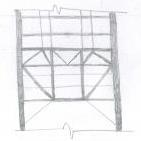Leaderboard
Popular Content
Showing content with the highest reputation on 06/28/2012 in Posts
-

Long Term Deflection Multiplier
asadishaq and 4 others reacted to Badar (BAZ) for a topic
long term deflection multiplier accounts for deflection in members due to shrinkage and creep behavior in an approximate way. It is approximate because instantaneous dead deflection is multiplied by deflection multiplier and then this value is added in DL and LL deflection to get long-term deflection. Self weight multiplier option is used the software to compute dead weight of structure.If it is 1 then dead dead weight will be multiplied by 1. I edited title of thread as it can help in searching for particular topic in forum,I hope you will not mind.5 points -

Long Term Deflection Multiplier
Waqar Saleem and one other reacted to jammer3425 for a topic
first question is what is the purpose of long term deflection multiplier in safe software? 2. why do we give self weight multiplier while defining laod cases in ETABS?2 points -

Nice Move Admin!!!!
Yasir Saleem and one other reacted to Waqar Saleem for a topic
it is very nice step to have separate thread for job posting it is great helping hand for the one in need!!!thanx admin2 points -
Cracked And Uncracked Analysis
shahidthanvi and one other reacted to WR1 for a topic
Read chapter 10...Actually concrete cracks just after it reaches its tensile strength (about 7.5 to 10 or 12% of its compressive strength). before that the reinforcement is not taking action. So once concrete starts cracking...(when concrete cannot take tension) reinfrocement starts taking the tension. Now obviously when concrete cracks...we cannot analyze our section based on full inertia...so we have to reduce the stiffness, because its in reality. like this.. Now how we can reduce its properties? there are many methods...like the one given in chapter 10 of the code (ACI). like we reduce beam stiffness by 35% and column by 70% (uncracked) ... this is all relative.. I mean if you have only all the beams. even if you dont reduce stiffness it will be ok! but why we reduce stiffness is to redistribute internal forces from less stiff to more stiff areas like from beams (35%) to columns or walls (70% reduction).. So this way it ensures proper load path and distribution of loads based on stiffness2 points -

Diaphragm
Sameer Khan reacted to jammer3425 for a topic
what is the purpose of assigning diaphragm b4 running analysis of concrete structure in ETABS and what type of diaphragm is required to be assigned to the structure as it shows us two types rigid and semi rigid. what role does these factors governs or play in the design of the structure?1 point -
Spiral Ties Length!!!
Waqar Saleem reacted to WR1 for a topic
determine the dia of spiral by subracting dia of column-cover and then as you know circum = pi D..thats the length of one round approx... divide the column height covered with spiral divide by spacing + 1 that is the number of ties1 point -

Vulnerability Assessment!!!
Ayesha reacted to Kamran Munir for a topic
actually i did it wit pushover analysis on drain 3dx and then some matlab code to produce the vulnerability curves.....1 point -
1 point
-

Diaphragm
Majdoline reacted to UmarMakhzumi for a topic
Here, My fav on diaphargms Diaphragm behavior and idealizations Rigid diaphragms, symmetry, and relative stiffness All frames equal stiffness Symmetrically arranged & equal stiffness means equal resistance Under the rigid diaphragm idealization, the symmetrically arranged identical frames experience the same deflection, and provide equal resistance. Center frame is twice as stiff All frames equal stiffness Third frame is twice as stiff All frames equal stiffness Third frame is twice as stiff Third frame is twice as stiff Concrete slab Ideal rigid diaphragm Concrete slab1 point -

Long Term Deflection Multiplier
haro0n reacted to jammer3425 for a topic
never mind sir infact thanx alot sir may many and many people join in and get alot of benefits by sharing the knowledge as sharing knowledge increases the knowledge as you ppl are doing so alot of prayers and praises1 point -
live load will be reduced if you select so from preferences option1 point
-

Cracked And Uncracked Analysis
UmarMakhzumi reacted to Badar (BAZ) for a topic
A method to reduce stiffness properties (I , J) of section when section cracks.1 point -

Pre-Engineered Buildings
Engr1 reacted to Muhammad Ali Dayo for a topic
Basic Building Parameters The basic parameters that define a pre-engineered building are: Building Width, Building Length, Building Height, Roof Slope, End Bay Length, Interior Bay Length, and Design Loads. BUILDING WIDTH: No matter what primary framing system is used, the building width is defined as the distance from outside of eave strut of one sidewall to outside of eave strut of the opposite sidewall. Building width does not include the width of Lean-To buildings or roof extensions. BUILDING LENGTH The longitudinal length of the building measured from out to out of end wall steel lines. BUILDING HEIGHT: Building height is the eave height which usually is the distance from the bottom of the main frame column base plate to the top outer point of the eave strut. When columns are recessed or elevated from finished floor, eave height is the distance from finished floor level to top of eave strut. ROOF SLOPE: This is the angle of the roof with respect to the horizontal. The most common roof slopes are 0.5/10 and 1/10. Any practical roof slope is possible. END BAY LENGTH: The distance from outside of the outer flange of endwall columns to center line of the first interior frame column. INTERIOR BAY LENGTH: The distance between the center lines of two adjacent interior main frame columns. The most common bay lengths are 6 m, 7.5 m and 9 m. DESIGN LOADS: Unless otherwise specified Steel pre-engineered buildings are designed for the following minimum loads: Roof Live Load: 0.57 kN/m2 Design Wind Speed: 110 km/h Design for snow loads, earth quake loads, collateral loads, crane loads or any other loading condition, if required must be specified. Source: zamilsteel.com1 point -

Job Places
umair siddiqui reacted to Shahjahan for a topic
i am working for the installation/execution/construction of over head transmission lines. it is only good for those who can travel minimum 300 km/day, believe in long distance relationships and having only half of brain active. for consultancy, the issues are very technical and are very romantic to handle1 point